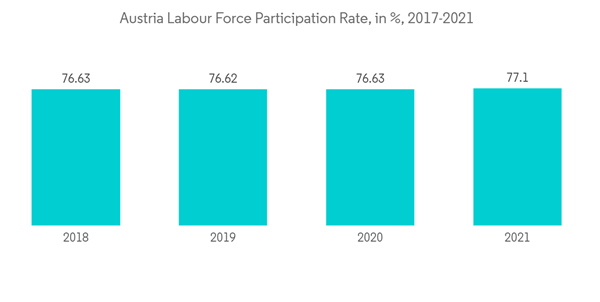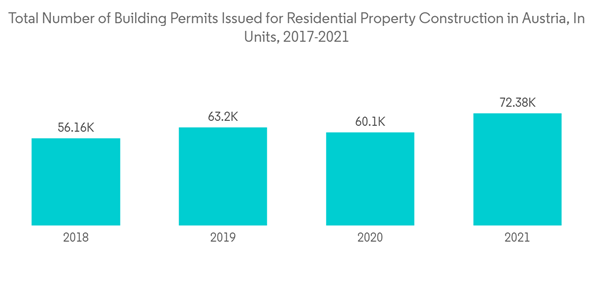Key Highlights
- The demand for low- to mid-rise residential structures, project homes, and public housing drives the market. Austria's prefabricated home market is expanding as consumers place more importance on turnkey solutions that meet all of today's requirements. Prefabricated housing is expanding steadily in Austria as the emphasis on turnkey solutions grows.
- An improving economy and rising demand for affordable housing solutions have been the main drivers of Austria's prefabricated housing market's robust growth over the past few years.The market has been focused on modernizing its housing sector, increasing the availability of off-site-built structures, and raising awareness about the advantages of prefabricated housing. Additionally, the government has been actively involved in promoting sustainable construction and has provided tax incentives for developers who opt for prefabricated housing. The market is further boosted by the growing interest from investors, particularly from China and other countries looking to set up production plants. Furthermore, the emergence of fully automated building systems and modular homes has gained traction in the market. The overall outlook for Austria's prefabricated housing market over the next few years remains positive, and the country's robust tourism industry is expected to be a long-term driver of growth.
- The impact of the COVID-19 pandemic on Austria's prefabricated housing market was varied. The suspension of construction projects and limitations on building materials due to social-distancing measures affected the sector to a certain extent. As a result, some suppliers saw their order books drop or suffer from delivery delays. On the other hand, the demand for prefabricated housing projects kept increasing, as these could be completed more rapidly in comparison to traditionally built projects and increase the social versatility of housing in urban areas. Furthermore, the affordability factor of prefabricated housing makes it an attractive housing solution for those looking to purchase their own homes.
Austria Prefabricated Housing Market Trends
The decrease in Labor Force in Austria is driving the demand of prefabricated houses
In the last quarter, 77.0% of Austrians were working. In June 2022, that number went up to 77.1%.The average rate of labor force participation in Austria is 77.1% and is available from March 2021 to June 2022. The data peaked at 77.9% in September 2021 and reached a record low of 76.3% in June 2021. Statistics Austria publishes data on the labor force participation rate in Austria. According to the most recent statistics, Austria's population surpassed 9.0 million in December 2021. Austria's unemployment rate decreased to 4.6% in October 2022.Governments all over the world are spending money on alternatives to traditional building techniques to help make housing more affordable. The Prefabricated Houses Act 2015 and Housing Construction Incentives Program have made prefabricated homes more accessible and much more economical. People are increasingly realizing the benefits of such dwellings: they can be built much faster with limited disruption, offer greater energy efficiency, and allow for easy modification or expansion. With stringent modern energy standards being legislated in many places, it's no wonder that prefabricated houses are becoming increasingly popular - they ensure compliance with those legislation requirements.
Investments in Prefab Industry Boosting the Residential Property Construction in Austria
The index for new dwellings, which increased by 14.8% in the first half of 2022 compared to the same period in the previous year (Q1: +15.6%, Q2: +14.0%), tracked the price of newly constructed apartments and prefabricated homes.The price of existing homes climbed by the least, 12.7% (Q1: +14.3%, Q2: +11.1%), and the price of existing apartments increased by the most, 13.2% (Q1: +14.3%, Q2: +12.2%). The index for existing homes gained 13.0% overall (Q1: +14.3%, Q2: +11.7%).In Austria's building sector, prefabricated construction technology has recently attracted increased attention. The prefab business is expanding as a result of rising investments in the construction sector. To solve the issues in the housing market, the government intends to construct more new homes. There, prefabrication is anticipated to be crucial. The major market players have begun investing in increased performance and productivity in response to the market's growth potential and the use of modular construction approaches. A rise in technologically driven projects that employ fundamental ergonomics to explain living comfort can be found in the residential sector.
Austria Prefabricated Housing Industry Overview
In Austria, there is a lot of competition in the market for prefab homes. No one company controls most of the market. Despite the market's fragmentation, growth is anticipated throughout the forecast period. The market has seen the birth of various cutting-edge and new products due to increased competition, including turnkey solutions and lightweight ceramic homes. As a result, for suppliers, establishing sustainability, growing abroad, and increasing domestic demand are all crucial. Major players are Swietelsky AG, Wolf Holding GmbH, Haas GmbH, ELK Fertighaus GmbH, and Wimberger Holding GmbH.Additional Benefits:
- The market estimate (ME) sheet in Excel format
- 3 months of analyst support
This product will be delivered within 2 business days.
Table of Contents
1 INTRODUCTION1.1 Study Assumptions
1.2 Scope of the Study
2 RESEARCH METHODOLOGY
2.1 Analysis Methodology
2.2 Research Phases
3 EXECUTIVE SUMMARY
4 MARKET INSIGHTS
4.1 Current Market Scenario
4.2 Technological Trends
4.3 Insights on Supply Chain/Value Chain Analysis of the Prefabricated Housing Industry
4.4 Cost Structure Analysis of the Prefabricated Housing Industry
4.5 Insights on Different Types of Materials used in Prefabricated Housing Construction
4.6 Impact of COVID-19 on the Market
5 MARKET DYNAMICS
5.1 Drivers
5.2 Restraints
5.3 Opportunities
5.4 Industry Attractiveness - Porter's Five Forces Analysis
5.4.1 Bargaining Power of Suppliers
5.4.2 Bargaining Power of Consumers / Buyers
5.4.3 Threat of New Entrants
5.4.4 Threat of Substitute Products
5.4.5 Intensity of Competitive Rivalry
6 MARKET SEGMENTATION
6.1 By Type
6.1.1 Single Family
6.1.2 Multi Family
7 COMPETITIVE LANDSCAPE
7.1 Overview
7.2 Company Profiles
7.2.1 Swietelsky AG
7.2.2 ELK Fertighaus GmbH
7.2.3 Wimberger Holding GmbH
7.2.4 Kieninger Gesellschaft
7.2.5 Georg Fessl GmbH
7.2.6 Karmod
7.2.7 Palmatin
7.2.8 Wolf Systembau Gesellschaft m.b.H.
7.2.9 Schmid Hochbau GmbH
7.2.10 Austrohaus*
8 MARKET OPPORTUNITIES AND FUTURE TRENDS
9 APPENDIX
9.1 Macroeconomic Indicators (GDP Breakdown by Sector, Contribution of Construction to Economy, etc.)
9.2 Key Production, Consumption, Exports, and Import Statistics of Construction Materials
Companies Mentioned (Partial List)
A selection of companies mentioned in this report includes, but is not limited to:
- Swietelsky AG
- ELK Fertighaus GmbH
- Wimberger Holding GmbH
- Kieninger Gesellschaft
- Georg Fessl GmbH
- Karmod
- Palmatin
- Wolf Systembau Gesellschaft m.b.H.
- Schmid Hochbau GmbH
- Austrohaus*










